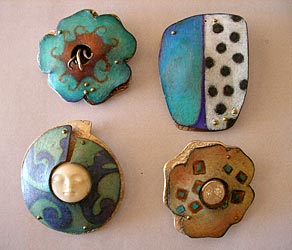Debra Weld Brings out the Colorful Side of Copper
 Colored copper jewelry by Debra Weld
Colored copper jewelry by Debra WeldPhotograph by Larry Sanders
Jewelry designer and metalsmith Debra Weld has utilized numerous materials and techniques in her work, but a few years ago, she developed her own spin on the application of color to copper without the use of enamel. She calls her technique, "Show Me the Color," and now teaches it at various venues throughout the U.S. and Mexico.
Debra begins with scrap copper picked up from a local refinery, which she then cuts and sands with a coarse sandpaper. After cleaning the metal with liquid detergent and alcohol and allowing it to dry, she applies a patina made specifically for copper by Jax Chemical Company. She prefers their green patina, which makes the metal a bit rougher in order to take the color better. She lets the patina sit for 12 to 24 hours so it moves into all of the valleys she sanded into the copper. Only then does she begin adding color.
Debra prefers Prismacolor pencils because they're very highly concentrated pigments which contain a small amount of wax for a smoother texture. She always starts with a very light color and, rather than using the tip of the pencil, she uses the sides to put a very light touch all the way across the copper.
Next, she dips a paintbrush in turpentine and applies it to the color to disintegrate the pigment, patting the turpentine with her brush to dissolve the color into the valleys of the copper. After that dries, she adds another layer and repeats the process. Generally, she applies two layers of turpentine, but sometimes three are required.
Then, she's ready to begin her design. She always works light to dark, using the darkest color toward the end of the process.
"Sometimes I'll shade a red apple with green in certain spots or purples or yellows, but again, the touch is very light," she says.
Eventually, the copper will reach a point where it no longer will accept color. This can happen after five layers or 50 depending upon the design. The piece is then placed in a toaster oven for 5 to 10 minutes at about 275 degrees. During this time, the wax within the color is melted into the valleys of the copper. After it air-cools, Debra sprays the piece with a sealer such as Krylon, which will dry in 5 to 15 minutes, after which she applies another layer of color. She may repeat this process as many as seven times, depending upon the desired effect.
She then uses a product called Renaissance Wax, applying a thin layer with her finger. The piece goes back into the toaster oven for another 5 to 10 minutes, and after it has completely cooled, she uses a cloth similar to a sweatshirt to rub off any residue. To buff the piece to a high gloss, she uses denim or fuzzy chenille. The color seals very well, and the finished jewelry is remarkably durable.
The back plate of the finished piece is made of Precious Metal Clay or PMC, a product developed in Japan by Mitsubishi Materials Corporation, which consists of 99% pure silver fine particles mixed with water and a binding agent similar to cornstarch. It allows you to roll out the metal, sculpt it, or carve it.
"I had done silversmithing years ago and I really liked how casting looked with silversmithing," says Weld. "But I'm lazy. So, I did a lot of fabricated pieces because I just didn't like all the cleanup. PMC will do the casting look, and it's easier to clean it before you fire it."
Debra is especially interested in working with PMC and wants to show the world that the clay is not a shortcut to working with metal but is capable of creating very refined jewelry.
"If you have the word 'clay' in it, people automatically assume it's cheap and easy to work with," she says. She is adamant that it is not a "craft" product, however, and she plans to soon create works with PMC and fused glass.
While she is now based in Kansas City where she grew up and studied art, Debra lived in Alaska for many years. As a result of living in a place that was dark so much of the year, she became especially enamored with color, which remains her main inspiration. "Color makes me happy," she says. "It makes me feel content."
Also in this Issue:
- The NSS: Preserving the Legacy of Sculpture
- Revere Copper: America's Founding Foundry
- Debra Weld Brings out the Colorful Side of Copper
- The American Bronzing Company: Precious Today, Priceless Tomorrow
- Sculpture in Public: Part 2, Public Art
